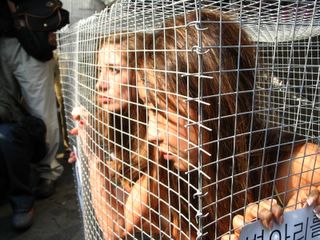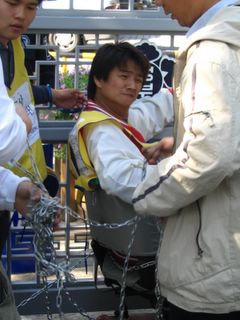KFC Target of Bikini-clad PETA Protest
Monday, October 24th, 2005(From The Korea Herald, October 2005)
by Tracey Stark

Brandi Vallodolid and Christina Cho stayed in a cage for more than an hour on Monday, October 24, 2005 to protest the inhumane treatment of chickens used by KFC in Seoul.
Two bikini-clad protesters squatted in a small cage for more than an hour yesterday in front of a KFC in Seoul to protest the inhumane treatment of chickens supplied to the fast food chain.
As the regular lunch hour was beginning in Seoul, two women in yellow bikinis and silver high heels walked down the street carrying a small wire cage and signs that read, ”KFC Tortures Chicks,” in both English and Korean, stopped in front of the fast food restaurant, squatted on the ground and placed the cage over their heads.
They were in Seoul as part of People for the Ethical Treatment of Animals’ ongoing protest – called ”Kentucky Fried Cruelty” – against what they say is the fast food chains’ suppliers’ continual inhumane treatment of chickens.
The cage was less than one meter wide, and three-quarters of a meter deep and tall. But the women were not complaining about the cramped space.
“It’s not as uncomfortable as having a beak cut off and being trampled in a cage my entire life,” said Brandi Vallodolid, who works at PETA’s main U.S. office in Norfolk, Virginia.
“We have way more space than the chickens do. Their personal living space is smaller than a standard sheet of paper,” Christina Cho, a classical pianist and part-time activist added.
According to PETA’s website and a documentary narrated by actress Pamela Anderson, the chickens supplied to KFC live in over-crowded conditions, develop diseases from high ammonia levels, become lame and crippled from drugs that speed up growth and accidents related to being top heavy, and when they are caught for slaughter they are often thrown violently into small containers, resulting in broken legs and wings. The video also showed the operation of a beak-trimming machine used on young chicks.
The slaughtering process, PETA claims, is even worse. First, the chickens are hung upside down, then run through a stun bath, with voltages so low the chickens are often completely conscious. The chickens’ throats are then slit and they are next dipped into scalding hot water for feather removal. Again, PETA says, the chickens are still often conscious.
“The beak-trimming machine shown in the PETA video … is no longer in common use in our industry,” said Richard Lobb, a spokesperson for the National Chicken Council.
PETA spokesperson Bruce Friedrich insisted that all the video was shot within the last year and a half of its release.
KFC could not be reached for comment, but animal welfare guidelines and press releases at http://www.kfc.com/ refute every accusation that PETA has made.
“As a major purchaser of food products, we have the opportunity, and responsibility, to influence the way animals supplied to us are treated. We take that responsibility very seriously, and we are monitoring our suppliers on an ongoing basis … As a consequence, it is our goal to only deal with suppliers who promise to maintain our high standards and share our commitment to animal welfare.

They also show their animal welfare and poultry guidelines, covering comfort and shelter, catching, transport, holding, stunning, and humane slaughter. ”If an audit reveals dirty or sick birds, corrective action at the grow-out house must be taken by the supplier,” KFC’s website said.
The website also lists an animal welfare council consisting of animal welfare experts. ”In consultation with our Council, Yum! Brands (the parent company of KFC) has developed guidelines and audit programs for our suppliers in the broiler industry,” the website said.
Broilers are chickens used for their meat.
Several of the people still listed on the website have recently resigned their posts over a proposed confidentiality agreement: Dr. Temple Grandin, Colorado State University and Dr. Ian Duncan, Department of Animal & Poultry Science, University of Guelph, Ontario. The agreement would prevent them from speaking to the press about any of their findings or conclusions related to KFC suppliers.
In a Chicago Tribune article former advisor Adele Douglass said that KFC ”never had any meetings. They never asked for any advice, and then they touted to the press that they had this animal-welfare committee. I felt like I was being used.”
Although PETA had no concrete information about suppliers of Korea’s KFC restaurants they say it is the same everywhere.
“We’ve never done an investigation anywhere where there weren’t egregious violations. It’s the nature of mass production, but they have to find a way to do it humanely,” Vallodolid said.
One such supplier was Pilgrim’s Pride, in West Virginia. Hidden video cameras caught workers stomping on the chickens, drop-kicking them like footballs and throwing them violently against a wall. And it appeared that the workers were doing it for fun.
The footage was shot by a PETA investigator who worked from October 2003 to May 2004 at the Pilgrim’s Pride plant in Moorefield, which won KFC’s ”Supplier of the Year” award in 1997.
KFC’s president Gregg Dedrick said in a press conference after the release of the video in July 2004, ”As a responsible corporate citizen, we require all our suppliers to treat animals humanely. This behavior by Pilgrim’s Pride employees is not only appalling, it violates the standards we have in place for all our suppliers.”
“We think it’s outrageous that PETA is unfairly singling out KFC. They’ve done this because we’re the most recognized brand selling chicken today, and our name, Kentucky Fried Chicken, is synonymous with chicken. So we have become their target. The truth is, we sell about 5 percent of all the chicken in America today – that’s less than the leading burger chain.”
Dedrick added, ”PETA’s campaign distorts the truth and we would ask the media to report the true facts of the situation.”
Cho was arrested in Korea in January this year for a similar protest in Myeong-dong, Seoul. The difference then was that she and a cohort were topless. She was charged with indecent exposure and blocking traffic.
She added that the policeman who arrested her told her that he didn’t want to, but had to do his job. ”He said he hoped his daughters would be like me and stand up for what they believe in.”
As for protesting in bikinis and even topless, they say it is the best way to attract the most attention.
“It’s the MTV generation. We have to do something flashy or we just won’t get people’s attention,” said Jason Baker of PETA Asia-Pacific, and one of the organizers of this protest. ”If you just hold up a sign people just don’t care.”
He said that he has been in the cage before on demonstrations and attracted a lot of media attention. ”But nothing like this,” he said, pointing at the swarm of camera men and women.
“We’re not here to make a problem. We’re here to bring awareness to people everywhere,” Cho said from inside the cage.
Vallodolid added, ”This leads to more hits on the website – http://www.peta.org/ – and that leads to change.”
The protest ended after about an hour without incident.(traceystark@heraldm.com)


